A User-Centered Mobile Cloud Computing Platform for Improving Knowledge Management in Small-to-Medium Enterprises in the Chilean Construction Industry
Abstract
1. Introduction
2. Literature Review
2.1. Knowledge Management in SMEs
2.1.1. Success Factors for the Adoption of KM
2.1.2. Factors that Prevent the Adoption of KM
2.2. Knowledge Management Systems in SMEs
3. Knowledge Management Requirements in Construction SMEs
3.1. Desired Features of KM Platforms Aimed at Construction SMEs
3.2. Existing KM Platforms and Research Gap in Construction SMEs
3.3. MCC as an Opportunity for KM in Construction SMEs
4. Materials and Methods
4.1. Research and Development Method
4.2. Research Cycles
4.2.1. First Cycle
4.2.2. Second Cycle
4.2.3. Third Cycle
4.3. Empirical Evaluation for the Measure Phase
5. The Proposed KM MCC Platform
5.1. The Architecture of the KM Platform
- Mobile UI: Cross-platform mobile application to be installed on the devices of on-site professionals. It is associated with requirements R1, R2, R3, R4, R5, R6, R7, R8, R9, and R10.
- Web UI: Web application that is accessible from any device with a Web browser. It is associated with requirements R1, R5, R6, R7, R8, R9, and R10.
- Cloud Backend as a Service: Application Programming Interfaces (APIs) that expose the functionalities of the application logic to the different UIs, adapting the requests and responses to the most suitable format and content for each of them. It is associated with requirements R4, R12, and R11.
- Application Logic: Centralized components that handle and implement the business logic, maintaining the consistency of the information regardless of which client accesses it. It is associated with requirements R3, R5, R6, R8, R9, and R10.
- Domain Models: Abstractions that represent the information units to be stored and/or processed (e.g., a lesson, a project, a microblog message, among others) and how they are related to each other. Are associated with requirements R5, R6 and R7.
- Cloud PaaS: Software components that access the services provided by the cloud vendor, in the form of a platform as a service. As a different cloud provider could be used in the future, it defines interfaces to be used by the rest of the application, providing a concrete implementation that depends on the cloud provider contracted at present. It is associated with requirements R11 and R12.
5.2. Web Application
5.2.1. Microblogging Platform
- Users have a personalized view in which they see the last public messages and the ones directly addressed to them.
- Messages can be addressed to all community members or to specific groups of users.
- Messages addressed to specific groups of users or individual users can be marked as private or public.
- Relevant messages for a particular user are highlighted. Their relevance is determined by three factors: whether or not it is directly addressed to a particular user, his or her role in the organization, and previous collaboration with the message’s author.
5.2.2. LL Database
- (a)
- Lesson creation
- (b)
- Lesson approval (R6 and R9)
- (c)
- Lesson search (R8)
- (d)
- Lesson evaluation (R6) and future recommendations (R8)
5.3. Mobile Application
5.3.1. Cross-Platform Implementation
5.3.2. Offline Usage and Data Synchronization
5.3.3. Cloud Backend as a Service
6. Platform Evaluation
6.1. Second Cycle Test—Platform Core Features
6.2. Third Cycle—Mobile Application With Cloud Backend
6.3. Limitations
7. Conclusions and Further Work
Acknowledgments
Author Contributions
Conflicts of Interest
References
- Egbu, C.O.; Robinson, H.S. Construction as a knowledge-based industry. Knowl. Manag. Constr. 2005, 4, 31–49. [Google Scholar]
- Kim, S. Impacts of knowledge management on the organizational success. KSCE J. Civ. Eng. 2014, 18, 1609–1617. [Google Scholar] [CrossRef]
- North, K.; Babakhanlou, R. Knowledge Management Tools for SMES. In Competitive Strategies for Small and Medium Enterprises; Springer: Cham, Switzerland, 2016; pp. 211–222. [Google Scholar]
- Production Development Corporation (CORFO). Hoja de Ruta Programa Estratégico Nacional Productividad y Construcción Sustentable 2025, Informe Final, Fase 3; Technical Report; CORFO: Santiago, Chile, 2016. [Google Scholar]
- Wong, K.Y.; Aspinwall, E. Development of a knowledge management initiative and system: A case study. Expert Syst. Appl. 2006, 30, 633–641. [Google Scholar] [CrossRef]
- Alavi, M.; Leidner, D.E. Knowledge management and knowledge management systems: Conceptual foundations and research issues. MIS Q. 2001, 25, 107–136. [Google Scholar] [CrossRef]
- Cerchione, R.; Esposito, E. A systematic review of supply chain knowledge management research: State of the art and research opportunities. Int. J. Prod. Econ. 2016, 182, 276–292. [Google Scholar] [CrossRef]
- Alvarez, I.; Cilleruelo, E.; Zamanillo, I. Is formality in knowledge management practices related to the size of organizations? The Basque case. Hum. Factors Ergon. Manuf. Serv. Ind. 2016, 26, 127–144. [Google Scholar] [CrossRef]
- Duffield, S.; Whitty, S.J. Developing a systemic lessons learned knowledge model for organisational learning through projects. Int. J. Proj. Manag. 2015, 33, 311–324. [Google Scholar] [CrossRef]
- Ling, C.T.N. Knowledge management acceptance: Success factors amongst small and medium-size enterprises. Am. J. Econ. Bus. Adm. 2011, 3, 73–80. [Google Scholar]
- Cheng, J.C.; Kumar, B. Cloud computing support for construction collaboration. Mob. Pervasive Comput. Constr. 2012, 237–254. [Google Scholar] [CrossRef]
- Ahuja, V.; Yang, J.; Skitmore, M.; Shankar, R. An empirical test of causal relationships of factors affecting ICT adoption for building project management: An Indian SME case study. Constr. Innov. 2010, 10, 164–180. [Google Scholar] [CrossRef]
- Lin, K.Y.; Tsai, M.H.; Gatti, U.C.; Lin, J.J.C.; Lee, C.H.; Kang, S.C. A user-centered information and communication technology (ICT) tool to improve safety inspections. Autom. Constr. 2014, 48, 53–63. [Google Scholar] [CrossRef]
- Poppendieck, M.; Poppendieck, T. Implementing Lean Software Development: From Concept to Cash; Pearson Education; Addison-Wesley: Boston, MA, USA, 2007. [Google Scholar]
- Ho, S.P.; Tserng, H.P.; Jan, S.H. Enhancing knowledge sharing management using BIM technology in construction. Sci. World J. 2013, 2013, 170498. [Google Scholar] [CrossRef] [PubMed]
- Deshpande, A.; Azhar, S.; Amireddy, S. A framework for a BIM-based knowledge management system. Procedia Eng. 2014, 85, 113–122. [Google Scholar] [CrossRef][Green Version]
- Nepal, M.P.; Staub-French, S. Supporting knowledge-intensive construction management tasks in BIM. J. Inf. Technol. Constr. 2016, 21, 13–38. [Google Scholar]
- Muñoz, V.; Arayici, Y. Using free tools to support the BIM coordination process into SMEs. Build. Inf. Model. Design Constr. Oper. 2015, 149, 33–41. [Google Scholar]
- Loyola, M. Encuesta Nacional BIM 2016: Informe de Resultados; Technical Report; Universidad de Chile: Santiago, Chile, 2016. [Google Scholar]
- Avram, M.G. Advantages and challenges of adopting cloud computing from an enterprise perspective. Procedia Technol. 2014, 12, 529–534. [Google Scholar] [CrossRef]
- Stieglitz, S.; Lattemann, C.; Brockmann, T. Mobile applications for knowledge workers and field workers. Mob. Inf. Syst. 2015, 2015. [Google Scholar] [CrossRef]
- Wang, Y.; Chen, R.; Wang, D.C. A survey of mobile cloud computing applications: Perspectives and challenges. Wirel. Pers. Commun. 2015, 80, 1607–1623. [Google Scholar] [CrossRef]
- Abolfazli, S.; Sanaei, Z.; Sanaei, M.H.; Shojafar, M.; Gani, A. Mobile Cloud Computing. In Encyclopedia of Cloud Computing; Wiley-IEEE Press: Hoboken, NJ, USA, 2016; pp. 29–40. [Google Scholar]
- Tarchinskaya, E.; Taratukhin, V.; Becker, J. Cloud-Based Engineering Design and Manufacturing: A Survey. In Emerging Trends in Information Systems; Springer: Cham, Switzerland, 2016; pp. 125–135. [Google Scholar]
- Du, J.; El-Gafy, M.; Lama, P. A Cloud-based shareable library of cooperative behaviors for Agent Based Modeling in construction. Autom. Constr. 2016, 62, 89–100. [Google Scholar] [CrossRef]
- Ibem, E.O.; Laryea, S. Survey of digital technologies in procurement of construction projects. Autom. Constr. 2014, 46, 11–21. [Google Scholar] [CrossRef]
- Chong, H.Y.; Wong, J.S.; Wang, X. An explanatory case study on cloud computing applications in the built environment. Autom. Constr. 2014, 44, 152–162. [Google Scholar] [CrossRef]
- Kim, C.; Park, T.; Lim, H.; Kim, H. On-site construction management using mobile computing technology. Autom. Constr. 2013, 35, 415–423. [Google Scholar] [CrossRef]
- Ko, H.S.; Azambuja, M.; Lee, H.F. Cloud-based materials tracking system prototype integrated with radio frequency identification tagging technology. Autom. Constr. 2016, 63, 144–154. [Google Scholar] [CrossRef]
- Moon, S.; Xu, S.; Hou, L.; Wu, C.; Wang, X.; Tam, V.W. RFID-Aided Tracking System to Improve Work Efficiency of Scaffold Supplier: Stock Management in Australasian Supply Chain. J. Constr. Eng. Manag. 2017, 144, 04017115. [Google Scholar] [CrossRef]
- Autodesk Inc. Autodesk BIM 360. Available online: http://bim360.autodesk.com (accessed on 29 January 2018).
- Graphisoft. BIMx. Available online: http://www.graphisoft.com/bimx (accessed on 29 January 2018).
- PlanGrid. PlanGrid. Available online: http://www.plangrid.com (accessed on 29 January 2018).
- Autodesk Inc. A360. Available online: https://a360.autodesk.com (accessed on 29 January 2018).
- Slack. Slack. Available online: https://slack.com (accessed on 29 January 2018).
- XWiki. XWiki. Available online: http://www.xwiki.org/xwiki/bin/view/Main/WebHome (accessed on 29 January 2018).
- AnswerHub. Available online: http://www.dzonesoftware.com (accessed on 29 January 2018).
- Centobelli, P.; Cerchione, R.; Esposito, E. Knowledge management in startups: Systematic literature review and future research agenda. Sustainability 2017, 9, 361. [Google Scholar] [CrossRef]
- Durst, S.; Runar Edvardsson, I. Knowledge management in SMEs: A literature review. J. Knowl. Manag. 2012, 16, 879–903. [Google Scholar] [CrossRef]
- Cerchione, R.; Esposito, E.; Spadaro, M.R. The spread of knowledge management in SMEs: A scenario in evolution. Sustainability 2015, 7, 10210–10232. [Google Scholar] [CrossRef]
- Cerchione, R.; Esposito, E.; Spadaro, M.R. A literature review on knowledge management in SMEs. Knowl. Manag. Res. Pract. 2016, 14, 169–177. [Google Scholar] [CrossRef]
- Cerchione, R.; Esposito, E. Using knowledge management systems: A taxonomy of SME strategies. Int. J. Inf. Manag. 2017, 37, 1551–1562. [Google Scholar] [CrossRef]
- Wong, K.Y.; Aspinwall, E. An empirical study of the important factors for knowledge-management adoption in the SME sector. J. Knowl. Manag. 2005, 9, 64–82. [Google Scholar] [CrossRef]
- Giotopoulos, I.; Kontolaimou, A.; Korra, E.; Tsakanikas, A. What drives ICT adoption by SMEs? Evidence from a large-scale survey in Greece. J. Bus. Res. 2017, 81, 60–69. [Google Scholar] [CrossRef]
- Centobelli, P.; Cerchione, R.; Esposito, E. Knowledge management systems: The hallmark of SMEs. Knowl. Manag. Res. Pract. 2017, 15, 294–304. [Google Scholar] [CrossRef]
- Centobelli, P.; Cerchione, R.; Esposito, E. Aligning enterprise knowledge and knowledge management systems to improve efficiency and effectiveness performance: A three-dimensional Fuzzy-based decision support system. Expert Syst. Appl. 2018, 91, 107–126. [Google Scholar] [CrossRef]
- Priyadarshinee, P.; Raut, R.D.; Jha, M.K.; Kamble, S.S. A cloud computing adoption in Indian SMEs: Scale development and validation approach. J. High Technol. Manag. Res. 2017, 28, 221–245. [Google Scholar] [CrossRef]
- Love, P.E.; Ackermann, F.; Teo, P.; Morrison, J. From individual to collective learning: A conceptual learning framework for enacting rework prevention. J. Constr. Eng. Manag. 2015, 141, 05015009. [Google Scholar] [CrossRef]
- Castro, A.; Yepes, V.; Pellicer, E.; Cuellar, A. Knowledge management in the construction industry: State of the art and trends in research. Revista de la Construcción 2012, 11, 62–73. [Google Scholar] [CrossRef]
- Yang, L.R.; Chen, J.H.; Wang, H.W. Assessing impacts of information technology on project success through knowledge management practice. Autom. Constr. 2012, 22, 182–191. [Google Scholar] [CrossRef]
- Tan, H.C.; Carrillo, P.M.; Anumba, C.J.; Bouchlaghem, N.; Kamara, J.M.; Udeaja, C.E. Development of a methodology for live capture and reuse of project knowledge in construction. J. Manag. Eng. 2007, 23, 18–26. [Google Scholar] [CrossRef]
- Dave, B.; Koskela, L. Collaborative knowledge management—A construction case study. Autom. Constr. 2009, 18, 894–902. [Google Scholar] [CrossRef]
- Bowden, S.; Dorr, A.; Thorpe, T.; Anumba, C. Mobile ICT support for construction process improvement. Autom. Constr. 2006, 15, 664–676. [Google Scholar] [CrossRef]
- Tan, H.C.; Carrillo, P.M.; Anumba, C.J. Case study of knowledge management implementation in a medium-sized construction sector firm. J. Manag. Eng. 2011, 28, 338–347. [Google Scholar] [CrossRef]
- Caldas, C.H.; Gibson, G.E., Jr.; Weerasooriya, R.; Yohe, A.M. Identification of effective management practices and technologies for lessons learned programs in the construction industry. J. Constr. Eng. Manag. 2009, 135, 531–539. [Google Scholar] [CrossRef]
- Eken, G.; Bilgin, G.; Dikmen, I.; Birgonul, M.T. A lessons learned database structure for construction companies. Procedia Eng. 2015, 123, 135–144. [Google Scholar] [CrossRef][Green Version]
- Ferrada, X.; Sepúlveda, M.; Serpell, A.; Núñez, D.; Neyem, A. A lessons-learned mobile system for construction companies: motivation and design. Procedia Eng. 2014, 85, 157–165. [Google Scholar] [CrossRef][Green Version]
- Forcada, N.; Fuertes, A.; Gangolells, M.; Casals, M.; Macarulla, M. Knowledge management perceptions in construction and design companies. Autom. Constr. 2013, 29, 83–91. [Google Scholar] [CrossRef]
- Davison, R.M.; Ou, C.X.; Martinsons, M.G. Information technology to support informal knowledge sharing. Inf. Syst. J. 2013, 23, 89–109. [Google Scholar] [CrossRef]
- Sage. Cloud Computing and the Construction Industry; Technical Report; Sage: Newcastle upon Tyne, UK, 2012. [Google Scholar]
- Lin, Y.C.; Wang, L.C.; Tserng, H.P. Enhancing knowledge exchange through web map-based knowledge management system in construction: Lessons learned in Taiwan. Autom. Constr. 2006, 15, 693–705. [Google Scholar] [CrossRef]
- Tserng, H.P.; Lin, Y.C. Developing an activity-based knowledge management system for contractors. Autom. Constr. 2004, 13, 781–802. [Google Scholar] [CrossRef]
- Paranagamage, P.; Carrillo, P.; Ruikar, K.; Fuller, P. Lessons learned practices in the UK construction sector: Current practice and proposed improvements. Eng. Proj. Organ. J. 2012, 2, 216–230. [Google Scholar] [CrossRef]
- Lin, Y.C. Construction 3D BIM-based knowledge management system: A case study. J. Civ. Eng. Manag. 2014, 20, 186–200. [Google Scholar] [CrossRef]
- Kivits, R.A.; Furneaux, C. BIM: Enabling sustainability and asset management through knowledge management. Sci. World J. 2013, 2013, 983721. [Google Scholar] [CrossRef] [PubMed]
- Chen, Y.; Kamara, J.M. Using mobile computing for construction site information management. Eng. Constr. Archit. Manag. 2008, 15, 7–20. [Google Scholar] [CrossRef]
- Du, J.; Shi, Y.; Zou, Z.; Zhao, D. CoVR: Cloud-Based Multiuser Virtual Reality Headset System for Project Communication of Remote Users. J. Constr. Eng. Manag. 2017, 144, 04017109. [Google Scholar] [CrossRef]
- Rosado da Cruz, A.M. Modern Software Engineering Methodologies for Mobile and Cloud Environments; IGI Global: Hershey, PA, USA, 2016. [Google Scholar]
- Thomas, B. Cloud Computing for Construction Accounting; Building Profits; CFMA: Princeton, NJ, USA, 2012. [Google Scholar]
- Silverio, M.; Renukappa, S.; Suresh, S.; Donastorg, A. Mobile Computing in the Construction Industry: Main Challenges and Solutions. In Leadership, Innovation and Entrepreneurship as Driving Forces of the Global Economy; Springer: Cham, Switzerland, 2017; pp. 85–99. [Google Scholar]
- Salah, D.; Paige, R.F.; Cairns, P. A systematic literature review for agile development processes and user centred design integration. In Proceedings of the 18th International Conference on Evaluation and Assessment in Software Engineering, London, UK, 13–14 May 2014; p. 5. [Google Scholar]
- Brhel, M.; Meth, H.; Maedche, A.; Werder, K. Exploring principles of user-centered agile software development: A literature review. Inf. Softw. Technol. 2015, 61, 163–181. [Google Scholar] [CrossRef]
- Da Silva, T.S.; Martin, A.; Maurer, F.; Silveira, M. User-centered design and agile methods: A systematic review. In Proceedings of the Agile Conference (AGILE), Salt Lake City, UT, USA, 7–13 August 2011; pp. 77–86. [Google Scholar]
- Ries, E. The Lean Startup: How Today’s Entrepreneurs Use Continuous Innovation to Create Radically Successful Businesses; Crown Books: Prince George’s County, MD, USA, 2011. [Google Scholar]
- Silva, S.E.; Calado, R.D.; Silva, M.B.; Nascimento, M. Lean Startup applied in Healthcare: A viable methodology for continuous improvement in the development of new products and services. IFAC Proc. Vol. 2013, 46, 295–299. [Google Scholar] [CrossRef]
- Carrillo, P.; Ruikar, K.; Fuller, P. When will we learn? Improving lessons learned practice in construction. Int. J. Proj. Manag. 2013, 31, 567–578. [Google Scholar] [CrossRef]
- Gao, S.; Krogstie, J.; Siau, K. Adoption of mobile information services: An empirical study. Mob. Inf. Syst. 2014, 10, 147–171. [Google Scholar] [CrossRef][Green Version]
- Brooke, J. SUS-A quick and dirty usability scale. Usabil. Eval. Ind. 1996, 189, 4–7. [Google Scholar]
- Brooke, J. SUS: A retrospective. J. Usabil. Stud. 2013, 8, 29–40. [Google Scholar]
- Bangor, A.; Kortum, P.T.; Miller, J.T. An empirical evaluation of the system usability scale. Int. J. Hum. Comput. Interact. 2008, 24, 574–594. [Google Scholar] [CrossRef]
- Tullis, T.S.; Stetson, J.N. A comparison of questionnaires for assessing website usability. In Proceedings of the Usability Professional Association Conference, Minneapolis, MN, USA, 7–11 June 2004; pp. 1–12. [Google Scholar]
- ISO. Iec25010: 2011 systems and software engineering–systems and software quality requirements and evaluation (square)–system and software quality models. Int. Organ. Stand. 2011, 34, 2910. [Google Scholar]
- Parra, D.; Sahebi, S. Recommender systems: Sources of knowledge and evaluation metrics. In Advanced Techniques in Web Intelligence-2; Springer: Berlin/Heidelberg, Germany, 2013; pp. 149–175. [Google Scholar]
- Borchers, A.; Herlocker, J.; Konstan, J.; Reidl, J. Ganging up on information overload. Computer 1998, 31, 106–108. [Google Scholar] [CrossRef]
- Corral, L.; Janes, A.; Remencius, T. Potential advantages and disadvantages of multiplatform development frameworks—A vision on mobile environments. Procedia Comput. Sci. 2012, 10, 1202–1207. [Google Scholar] [CrossRef][Green Version]
- Xamarin Inc. Xamarin. Available online: https://www.xamarin.com/platform (accessed on 29 January 2018).
- Neyem, A.; Ochoa, S.F.; Pino, J.A.; Franco, R.D. A reusable structural design for mobile collaborative applications. J. Syst. Softw. 2012, 85, 511–524. [Google Scholar] [CrossRef]
- Armbrust, M.; Fox, A.; Griffith, R.; Joseph, A.D.; Katz, R.; Konwinski, A.; Lee, G.; Patterson, D.; Rabkin, A.; Stoica, I. A view of cloud computing. Commun. ACM 2010, 53, 50–58. [Google Scholar] [CrossRef]
- Ricci, F.; Rokach, L.; Shapira, B. Introduction to recommender systems handbook. In Recommender Systems Handbook; Springer: Boston, MA, USA, 2011; pp. 1–35. [Google Scholar]
- Pazzani, M.J.; Billsus, D. Content-based recommendation systems. In The Adaptive Web; Springer: Berlin/Heidelberg, Germany, 2007; pp. 325–341. [Google Scholar]
- Kim, D.; Yum, B.J. Collaborative filtering based on iterative principal component analysis. Expert Syst. Appl. 2005, 28, 823–830. [Google Scholar] [CrossRef]
- Allam, H.; Nassiri, N.; Rajan, A.; Ahmad, J. A critical overview of latest challenges and solutions of Mobile Cloud Computing. In Proceedings of the 2017 Second International Conference on Fog and Mobile Edge Computing (FMEC), Valencia, Spain, 8–11 May 2017; pp. 225–229. [Google Scholar]
- Benedetto, J.I.; Valenzuela, G.; Sanabria, P.; Neyem, A.; Navón, J.; Poellabauer, C. MobiCOP: A Scalable and Reliable Mobile Code Offloading Solution. Wirel. Commun. Mob. Comput. 2018, 2018, 8715294. [Google Scholar] [CrossRef]

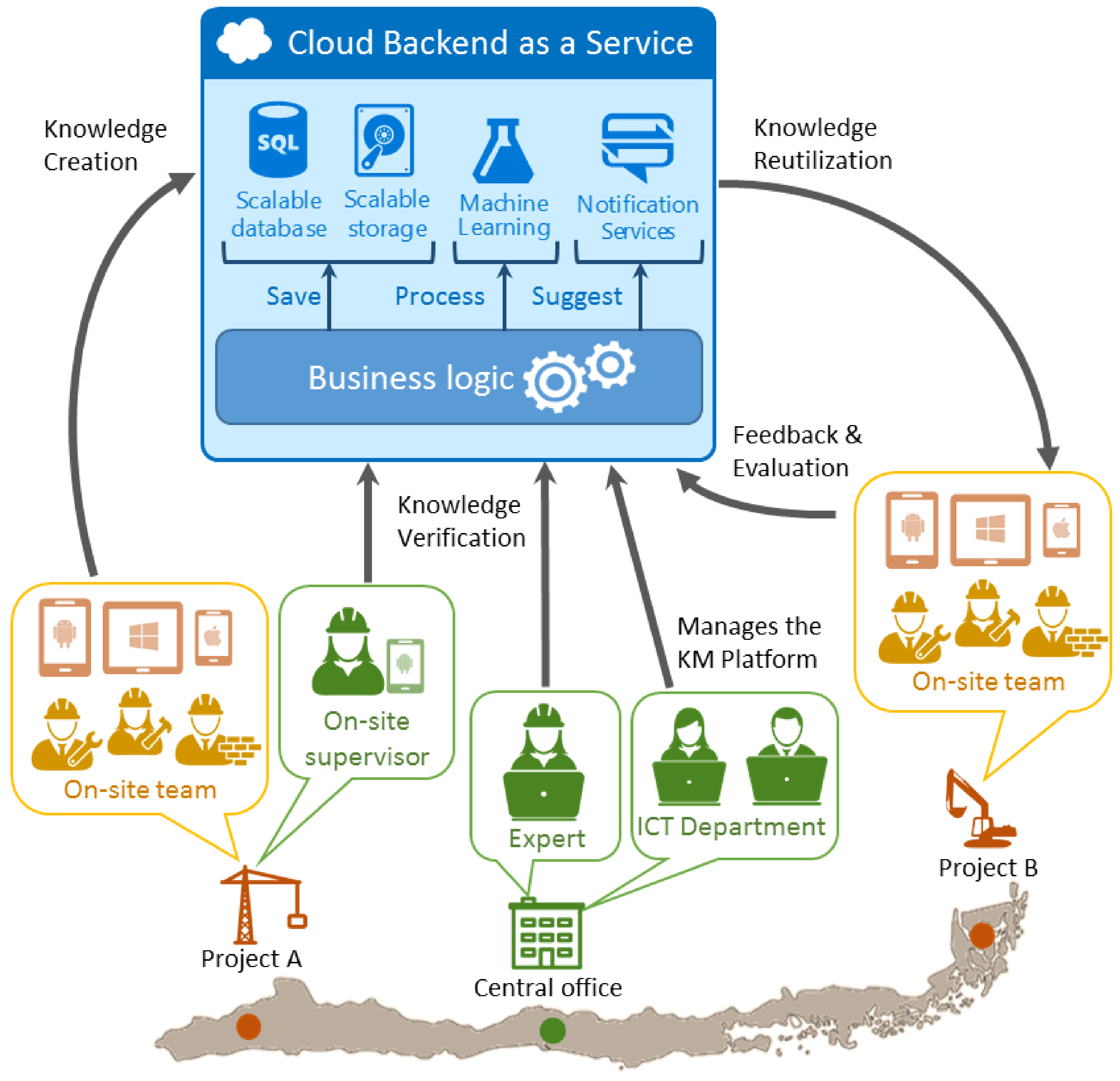
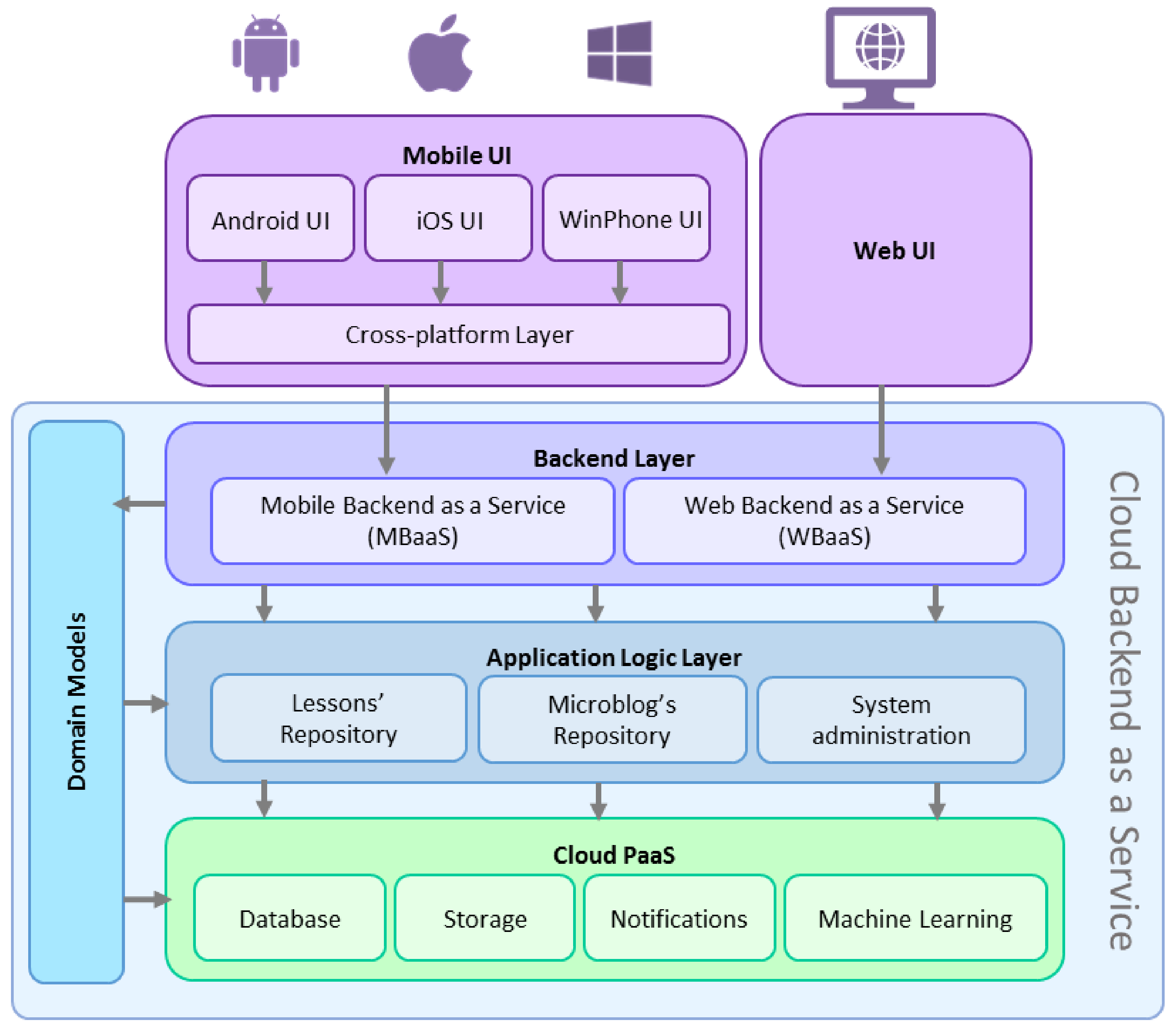

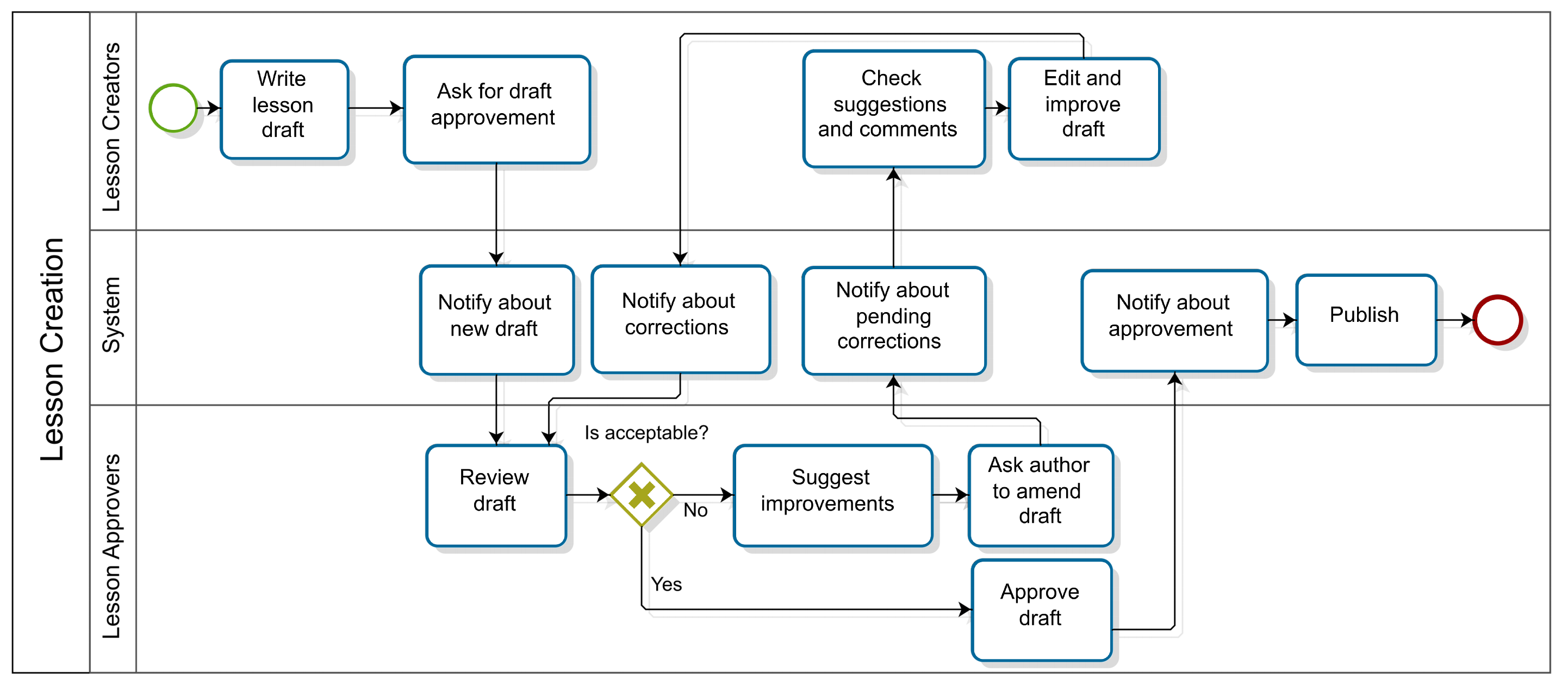


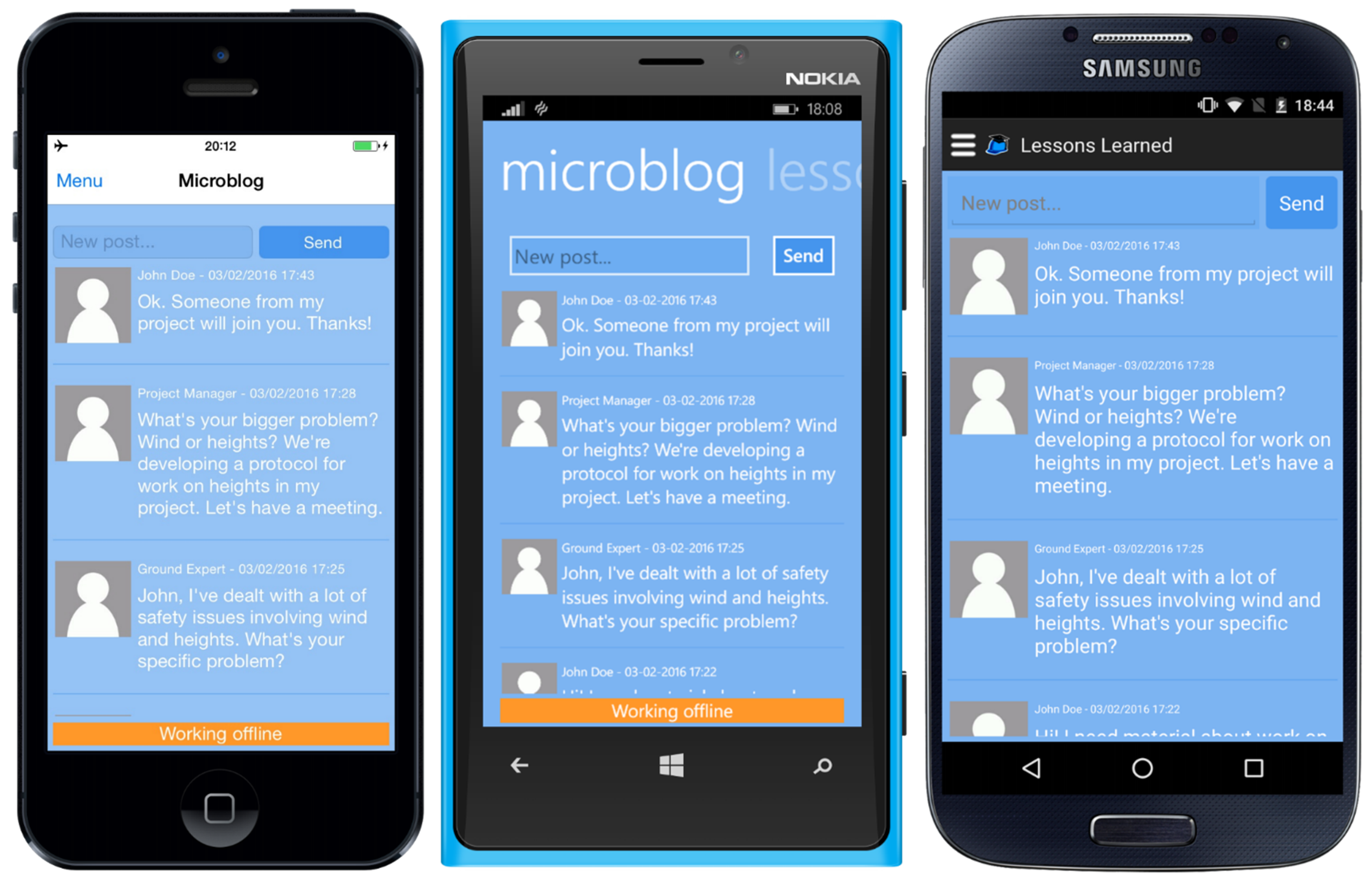
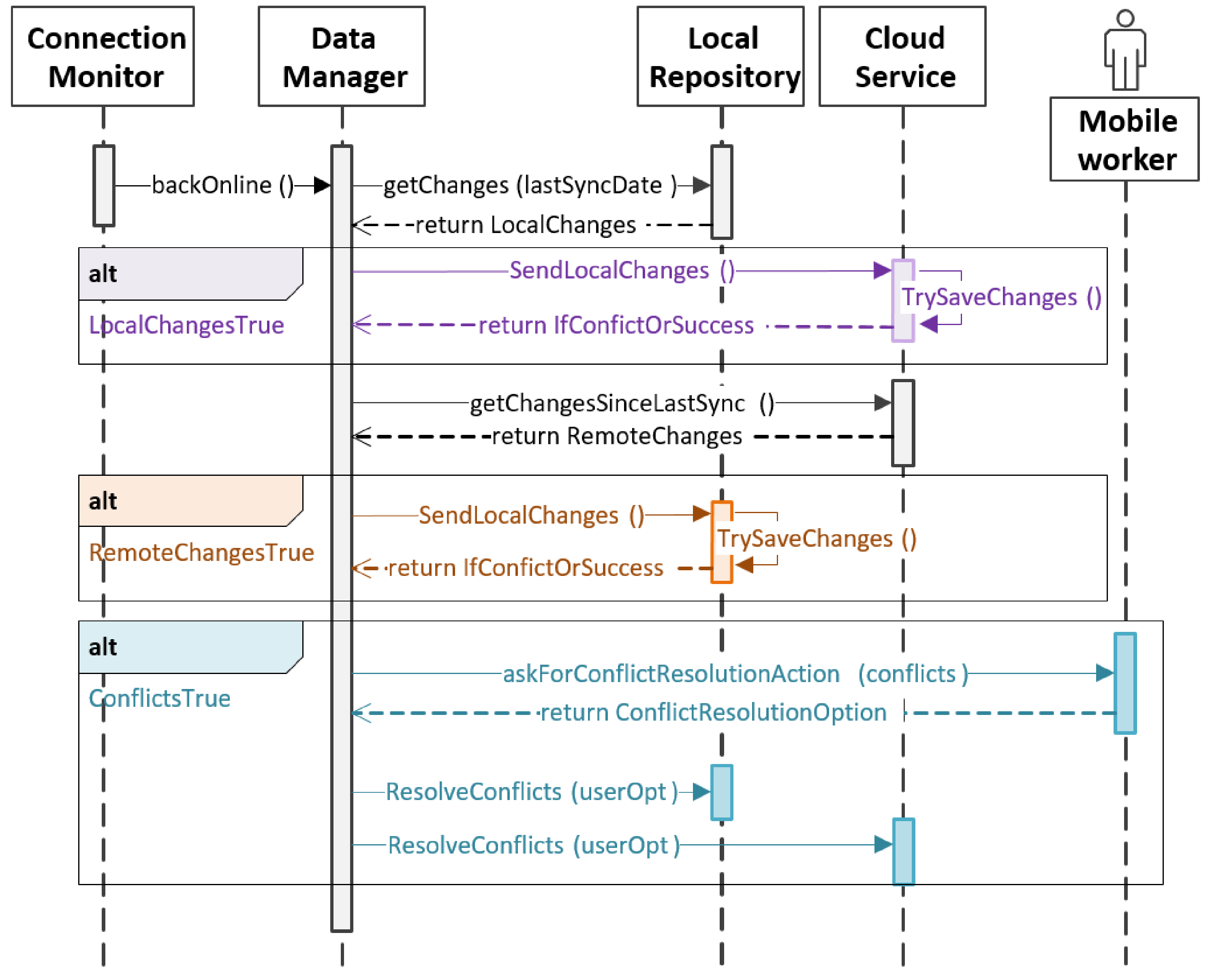

| Goal | Requirements |
|---|---|
| Integrate learning into daily operations and business development | R1: Live capture and sharing of knowledge |
| R2: On-site knowledge input | |
| R3: On-site knowledge reutilization | |
| R4: Being able to function with a low-speed, unstable, or non-existent Internet connection | |
| Achieve knowledge quality | R5: Identification and usage of different sources of knowledge |
| R6: Validation of knowledge | |
| Encourage construction professionals to use the KM platform despite their lack of time | R7: Readability of collected knowledge |
| R8: Ease and simplicity of use | |
| R9: Clarity about tasks, timing, and roles | |
| R10: Non-intrusiveness | |
| Coping with budget constraints | R11: Not being tied to specific or expensive PC hardware |
| R12: Interoperability at low cost |
| Requirements not Accomplished | Reason for Failure |
|---|---|
| R4: Being able to function with a low-speed, unstable, or non-existent Internet connection | Knowledge dissemination and real-time access needs a ubiquitous high-speed broadband Internet |
| R7: Readability of collected knowledge | Time and assistance needed to store or update knowledge |
| R8: Ease and simplicity of use | High PC requirements to run BIM |
| Time and assistance needed to store or update knowledge | |
| R11: Not being tied to specific or expensive PC hardware | High PC requirements to run BIM |
| R12: Interoperability at low cost | Upgrading to compatible BIM software versions involves high licensing costs |
| Question |
|---|
| 1. The system responds to my requests in a timely manner |
| 2. The system can be used in different environments, for example, at central office and on site |
| 3. The system prevents access by persons outside the company or without associated permissions |
| 4. The system offers a structured way of storing knowledge in the company |
| 5. The system provides a useful way of storing knowledge in the company |
| 6. The system allows quick access to the information and knowledge stored in the company |
| 7. The system will increase the amount of stored knowledge in the company |
| 8. The system will increase the amount of knowledge available to professionals in the company |
| 9. The system will allow the active participation of company’s professionals in the lessons learned process |
| 10. The knowledge stored in the system will improve the process of decision making in the company’s projects |
| 11. The system is suitable for use in everyday work |
| Evaluator | SUS Score | ISO-Quality Systems and | ISO-Quality Systems |
|---|---|---|---|
| Software Total Score (TS) | and Software TS/QA | ||
| A | 92.5 | 49 | 4.5 |
| B | 90.0 | 52 | 4.7 |
| C | 85.0 | 48 | 4.4 |
| D | 65.0 | 42 | 3.8 |
| E | 62.5 | 38 | 3.5 |
| F | 87.5 | 51 | 4.6 |
| Average | 80.42 | 46.67 | 4.25 |
| Evaluator | SUS Score | ISO-Quality Systems and | ISO-Quality Systems and |
|---|---|---|---|
| Software Total Score (TS) | Software TS/QA | ||
| G | 92.5 | 51 | 4.64 |
| H | 87.5 | 54 | 4.91 |
| I | 82.5 | 49 | 4.45 |
| J | 87.5 | 51 | 4.64 |
| K | 90.0 | 48 | 4.36 |
| L | 70.0 | 52 | 4.73 |
| M | 75.0 | 51 | 4.64 |
| Average | 83.57 | 50.86 | 4.62 |
© 2018 by the authors. Licensee MDPI, Basel, Switzerland. This article is an open access article distributed under the terms and conditions of the Creative Commons Attribution (CC BY) license (http://creativecommons.org/licenses/by/4.0/).
Share and Cite
Núñez, D.; Ferrada, X.; Neyem, A.; Serpell, A.; Sepúlveda, M. A User-Centered Mobile Cloud Computing Platform for Improving Knowledge Management in Small-to-Medium Enterprises in the Chilean Construction Industry. Appl. Sci. 2018, 8, 516. https://doi.org/10.3390/app8040516
Núñez D, Ferrada X, Neyem A, Serpell A, Sepúlveda M. A User-Centered Mobile Cloud Computing Platform for Improving Knowledge Management in Small-to-Medium Enterprises in the Chilean Construction Industry. Applied Sciences. 2018; 8(4):516. https://doi.org/10.3390/app8040516
Chicago/Turabian StyleNúñez, Daniela, Ximena Ferrada, Andrés Neyem, Alfredo Serpell, and Marcos Sepúlveda. 2018. "A User-Centered Mobile Cloud Computing Platform for Improving Knowledge Management in Small-to-Medium Enterprises in the Chilean Construction Industry" Applied Sciences 8, no. 4: 516. https://doi.org/10.3390/app8040516
APA StyleNúñez, D., Ferrada, X., Neyem, A., Serpell, A., & Sepúlveda, M. (2018). A User-Centered Mobile Cloud Computing Platform for Improving Knowledge Management in Small-to-Medium Enterprises in the Chilean Construction Industry. Applied Sciences, 8(4), 516. https://doi.org/10.3390/app8040516






